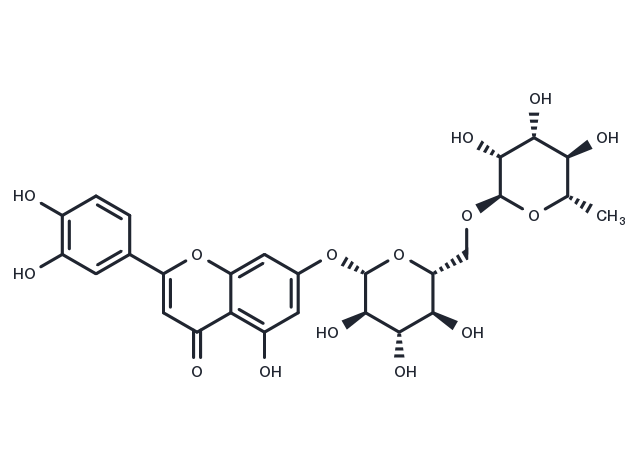Powder: -20°C for 3 years | In solvent: -80°C for 1 year


Luteolin-7-rutinoside has both antifungal activities and anti-arthritic, can result in a combination therapy for the treatment of fungal arthritis due to C. albicans infection.

| Pack Size | Availability | Price/USD | Quantity |
|---|---|---|---|
| 1 mg | 35 days | $ 188.00 | |
| 5 mg | 35 days | $ 597.00 | |
| 10 mg | 35 days | $ 1,120.00 | |
| 25 mg | 35 days | $ 2,340.00 |
| Description | Luteolin-7-rutinoside has both antifungal activities and anti-arthritic, can result in a combination therapy for the treatment of fungal arthritis due to C. albicans infection. |
| In vitro | Luteolin-7-rutinoside demonstrates dose-dependent immunomodulatory effects in T cells and macrophages. At concentrations of 40 μg/mL, it induces T cell proliferation at a rate comparable to that seen with 20 μg/mL, indicating a potential plateau in efficacy with increased dosage. A lower dose of 10 μg/mL (referred to as lonicerin) significantly reduces T cell proliferation by approximately 47% relative to control groups treated with Luteolin-7-rutinoside (p<0.05), highlighting its suppressive capability. Additionally, Luteolin-7-rutinoside shifts the Th1-Th2 balance towards Th2-type responses and inhibits nitric oxide (NO) production from macrophages, further evidencing its immunological influence. |
| Molecular Weight | 594.52 |
| Formula | C27H30O15 |
| CAS No. | 20633-84-5 |
Powder: -20°C for 3 years | In solvent: -80°C for 1 year
You can also refer to dose conversion for different animals. More
bottom
Please see Inhibitor Handling Instructions for more frequently ask questions. Topics include: how to prepare stock solutions, how to store products, and cautions on cell-based assays & animal experiments, etc.
Luteolin-7-rutinoside 20633-84-5 Others Luteolin 7 rutinoside Luteolin7rutinoside inhibitor inhibit
